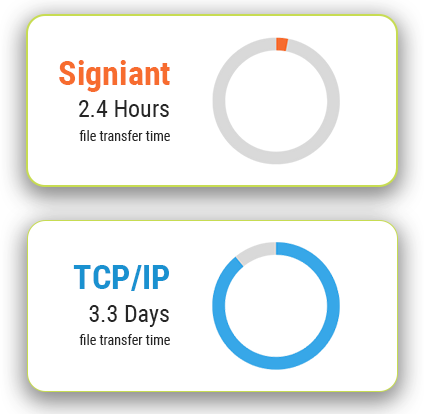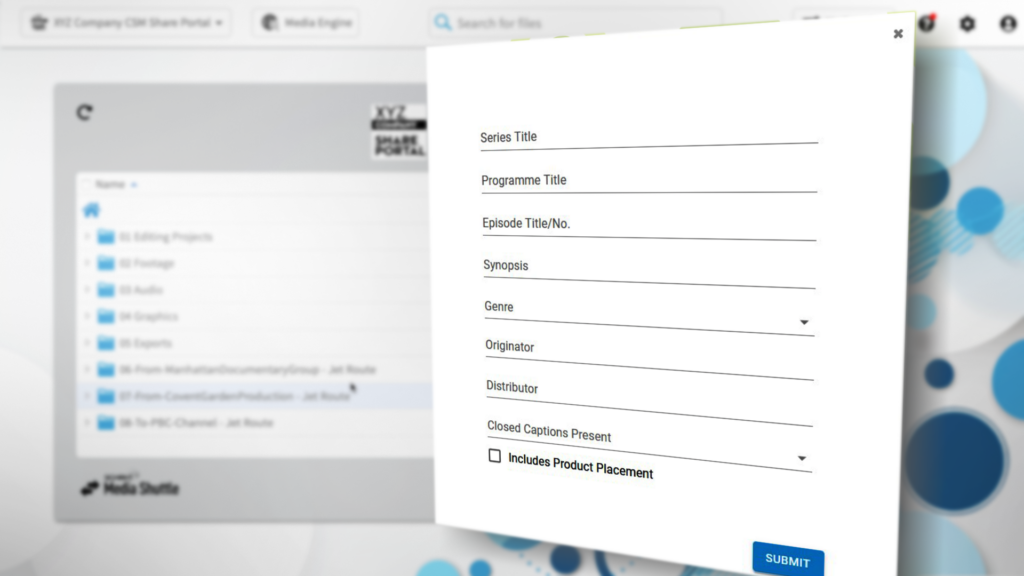What is UDP? A Simple Guide for Networking
Imagine you’re sending a package across the country, but you have no guarantee it will arrive safely or intact. Would you take the risk if it meant getting there faster? This is the trade-off that underpins the debate between UDP and TCP protocols in networking.
Today, Internet Protocol (IP)-based workflows are the backbone of media and entertainment production. From cloud editing to accelerated file transport to video signals moving over Ethernet networks, these systems have revolutionized how data moves across industries. At the core of these innovations lies the transport layer, ensuring data streams move swiftly and efficiently.
UDP, known for its speed, powers some of the most demanding workflows in technology. But why would anyone prioritize speed over reliability? This guide explores the world of UDP, breaking down how it works, its strengths, and why it remains an indispensable tool for engineers and technologists.
What is UDP?
UDP defined: UDP, or User Datagram Protocol, is a transport layer protocol designed for high-speed file transfers. Unlike its counterpart, Transmission Control Protocol (TCP), UDP prioritizes speed over reliability.
As a “connectionless protocol,” UDP sends data packets without waiting for confirmation of delivery before dispatching the next. This approach minimizes delays and accelerates the transfer process. However, the trade-off is clear: some packets might be lost or incomplete during transmission.
UDP and TCP Compared
TCP (Transmission Control Protocol) is the backbone of reliable internet communication, ensuring every data packet reaches its destination intact and in order. Unlike UDP, TCP guarantees delivery by retransmitting lost or delayed packets, making it the ideal choice for applications like web browsing, file downloads, and email — where precision matters.
However, reliability has a downside: It’s slow. TCP’s sliding window mechanism, which sends data incrementally while waiting for acknowledgments, introduces latency. This back-and-forth process can create bottlenecks, especially when transferring large files over long distances, making TCP slower than UDP in such scenarios.
Here’s a comparison chart outlining the major features of TCP and UDP:
| TCP | UDP | |
| Description | Reliable, connection-based | Fast, connectionless |
| Speed | Slower due to acknowledgments | Faster due to no handshakes |
| Reliability | High, ensures packet delivery | Low, no guarantees |
| Error Checking | Yes | Basic checksum only |
| Complexity | Higher | Lower |
| Latency | Higher | Lower |
| Stream Type | Stream-oriented | Message-oriented |
| Handshake | Required | Not Required |
How Engineers Use UDP in Networking
When transferring files over UDP, the application takes on the heavy lifting of managing packetization, transmission order, error detection, and reassembly. Unlike TCP, which ensures these tasks are handled automatically, UDP focuses on speed, leaving reliability to the application layer. Here’s how the process works:
1. Breaking Files into Packets
UDP does not segment data into packets. The application does instead. Each file is broken into smaller chunks, known as datagrams, and these must fit within UDP’s payload size limits to avoid fragmentation. Each datagram includes a simple header with essential details like source and destination ports, length, and a checksum.
2. Sending Packets
UDP sends packets independently, without establishing a connection between sender and receiver. They are dispatched as quickly as possible, based on the application’s logic, and without mechanisms to control flow rate. This can overwhelm networks if not managed properly.
3. Arrival and Reassembly
Because UDP doesn’t guarantee delivery or order, packets may arrive out of sequence, take different paths through the network, or fail to arrive at all. The receiving application must reorder packets, detect any missing ones, and reconstruct the original file. Basic error-checking is included, but applications often implement additional safeguards.
4. Addressing Loss and Errors
UDP doesn’t guarantee delivery, so applications must handle lost packets and request retransmission when needed. This adds complexity but allows for tailored solutions. By prioritizing speed over reliability, UDP shifts responsibility to the application — ideal when fast delivery matters more than complete accuracy.
Additional technical details
While we’re on the technical front, let’s discuss a few additional features that are key to using UDP. But don’t worry: we’ll tie all these technical details together with an example in the next section. Hang tight!
Optimizing Parallelism
Parallelism controls the number of simultaneous data streams — like lanes on a highway — that transport assets. While more lanes can boost speed, the effectiveness depends on the endpoints’ computing power and storage. For example, high-core machines using object storage thrive with multiple streams, while single-core systems with older storage technologies perform better with fewer.
Pipelining for Efficiency
Pipelining ensures efficient handling of file metadata, such as names and permissions, during transfers. When dealing with many small files or slower storage systems, opening files in parallel or optimizing metadata transfers can significantly improve performance. Modern protocols like Signiant’s allow for multiple files to move simultaneously over a single connection, reducing delays common in older methods like FTP.
Examples: UDP in Practice
Now that we’ve discussed the technical parts, let’s look at a practical file transfer example. Imagine you’re delivering critical information to a team across the globe. You have two options: take the cautious route, ensuring every detail is perfect but slowing down the process, or move at breakneck speed, knowing some pieces might not make it through unscathed. This is the essence of file transfers over UDP.
Real-world applications of UDP show why its speed-first design remains invaluable. From live broadcasts to real-time gaming, its low-latency capabilities make it ideal for situations where every millisecond counts.
Gaming: Real-Time Action
In multiplayer gaming, quick data exchange is critical for maintaining smooth gameplay. UDP facilitates real-time communication by transmitting game state updates, such as player movements or interactions, with minimal delay. Unlike TCP, where packet retransmission could create lag, UDP prioritizes speed, ensuring a seamless gaming experience even if some packets are lost.
Streaming: Low Latency for Live Broadcasts
UDP is often used in live video streaming, where delays must be kept to an absolute minimum. Platforms streaming events like sports or concerts rely on UDP to ensure viewers experience the action almost instantly. While some data might not make it, the human eye rarely notices these slight discrepancies, making UDP the ideal choice.
File Transfers: Balancing Speed and Functionality
Consider TFTP (Trivial File Transfer Protocol). Built on UDP’s fast foundation, TFTP adds basic reliability features like simple acknowledgments and retransmissions to ensure critical data isn’t entirely lost. It’s a balancing act: maintaining speed while adding just enough safeguards to keep things functional.
Why Choose UDP for File Transfers?
- Low Overhead: By eliminating extra layers like error-checking and connection management, UDP simplifies the process, enabling faster transmissions.
- Speed Advantage: Perfect for scenarios where time is critical, and some imperfections are acceptable—like live broadcasts or real-time data streams.
The Challenges of Using UDP
- Reliability Risks: Without built-in error-handling, developers must handle missing or corrupted data manually.
- Complexity: Applications require custom programming to handle tasks that TCP performs automatically, such as packet ordering and ensuring data integrity.
Shopping for the Right UDP Provider
Should You Use Open-Source UDP?
Open-source UDP is often the go-to for technologists seeking fast, customizable data transfer solutions without licensing fees. Its appeal lies in its simplicity and flexibility, making it a practical choice for rapid delivery on a budget.
However, this simplicity comes at a cost. Open-source UDP lacks essential features like error-checking, data integrity verification, and packet sequencing. These limitations can lead to data loss, corruption, and operational headaches — especially during network congestion or varying conditions. For SMBs and enterprises, this often translates to higher costs in maintenance and troubleshooting.
Advanced technologies like Signiant’s proprietary transport protocol solve these issues by combining UDP’s speed with TCP-like reliability. With features like error-checking, packet sequencing, and dynamic path optimization, Signiant ensures fast, dependable transfers even in fluctuating conditions. By reducing manual intervention, IT teams can focus on higher-value tasks, making it an ideal solution for organizations that demand both speed and reliability.
In other words: Enjoy speed and reliability.
TCP vs. Signiant Intelligent Transport

Signiant’s transport architecture simplifies data transfer by focusing on three key areas: selecting between TCP and its proprietary UDP protocol, adjusting parallelism, and optimizing pipelining. These factors determine how data is moved efficiently and reliably.
The choice between standard TCP and Signiant depends on variables like the distance between endpoints, network congestion, and the control over infrastructure. For instance, standard TCP works well for servers in the same data center, while Signiant excels in transferring data across continents, such as between Buenos Aires and Singapore.
Signiant’s technology dynamically selects the best settings for each scenario, ensuring data is delivered reliably and in sequence while optimizing performance to meet specific demands.
The Future of UDP and Advanced Data Transfer Technologies
Well done. If you’ve made it this far, you understand more about UDP than almost anyone: Pros, cons, use cases, and technical specs.
It goes without saying that UDP has become indispensable for modern production teams sending large files. By minimizing delays, UDP enables the swift transfer of large files and real-time media content, ensuring operations run smoothly and audiences remain engaged.
However, the limitations of open-source UDP — such as fixed parameters and lack of adaptability — can hinder performance during network fluctuations. Advanced solutions like Signiant’s proprietary transport protocol address these challenges by combining UDP’s speed with dynamic optimization and reliability, paving the way for seamless and efficient data transfers across industries.


